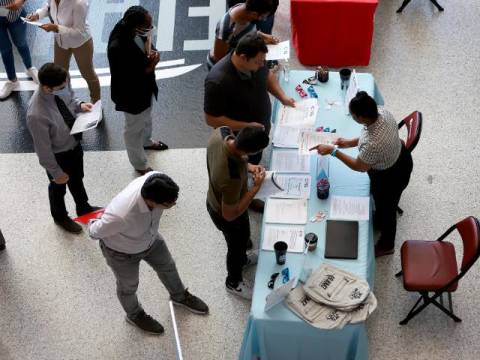The number of available jobs in the US shrank considerably in June, according to new data released Tuesday by the Bureau of Labor Statistics.

Job openings dropped to 10.7 million in June, down from a revised 11.3 million in May, according to the latest Job Openings and Labor Turnover Survey, or JOLTS. That's the lowest level since September 2021 but still above pre-pandemic levels of 7 million.
The retail and wholesale trade sectors saw the biggest pullback in unfilled jobs.
There were 5.91 million people unemployed in the US during June, so there were 1.8 available jobs for every person looking for a job.
Total hires and separations were little changed from the May: About 6.4 million people were hired, down slightly from 6.5 million in May. And the number of workers who quit their job was 4.24 million, largely unchanged from the previous month.
Layoffs totaled 1.3 million, down from 1.4 million in May.
At 600,000, the drop-off in the number of job openings was the largest monthly decline on record outside of the pandemic lockdown months of March and April 2020, according to BLS data, which goes back to December 2000.
Unfilled jobs ticking down in this manner could be a sign of weakness in the labor market in the coming months and hiring could slow down, said Julia Pollak, chief economist at ZipRecruiter.
When openings fall, that shapes everything else, she told CNN Business.
When there are fewer job openings to choose from, people become more reluctant to quit their jobs because they become less likely to find something new, she said, adding that it's also a sign that hiring activity will slow as employers grow more uncertain.
When recessions happen, many people think that layoffs are the big reason that unemployment rises and employment levels fall, but that's actually not what happens. Layoffs typically only pick up very, very slightly, she said. The action during a recession is in job openings and hires, and job openings decline quite substantially in a recession.
With little change in the numbers of separations or quits, that shows employers are taking down job postings as opposed to turning to layoffs, said Layla O'Kane, senior economist at Lightcast.
Employers are saying 'we're not going to lay people off, but we're going to give up on finding some of the talent we want,' O'Kane said in the statement.
That's welcome news to the Federal Reserve, said Nick Bunker, director of economic research at Indeed Hiring Lab. The central bank is looking for a slowdown in demand, implementing a series of hefty interest rates hikes to bring down the highest inflation in 40 years.
That means the ratio of job openings to unemployed workers has become a favored labor market indicator for the Fed, Bunker said. A higher ratio of openings to unemployed people indicates a labor market that is quite tight.
If their goal is to get the ratio closer to 1, then they have a ways to go, he said.
